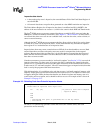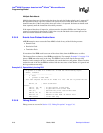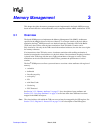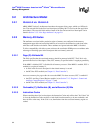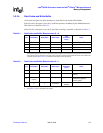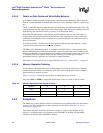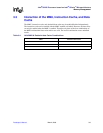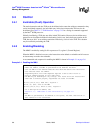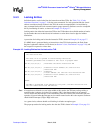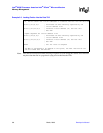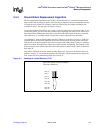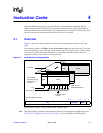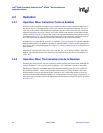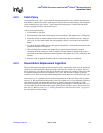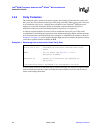
Developer’s Manual March, 2003 3-7
Intel
®
80200 Processor based on Intel
®
XScale
™
Microarchitecture
Memory Management
3.4.3 Locking Entries
Individual entries can be locked into the instruction and data TLBs. See Table 7-14, “Cache
Lockdown Functions” on page 7-14 for the exact commands. If a lock operation finds the virtual
address translation already resident in the TLB, the results are unpredictable. An invalidate by
entry command before the lock command ensures proper operation. Software can also accomplish
this by invalidating all entries, as shown in Example 3-2 on page 3-7.
Locking entries into either the instruction TLB or data TLB reduces the available number of entries
(by the number that was locked down) for hardware to cache other virtual to physical address
translations.
A procedure for locking entries into the instruction TLB is shown in Example 3-2 on page 3-7.
If a MMU abort is generated during an instruction or data TLB lock operation, the Fault Status
Register is updated to indicate a Lock Abort (see Section 2.3.4.4, “Data Aborts” on page 2-14), and
the exception is reported as a data abort.
Note: If exceptions are allowed to occur in the middle of this routine, the TLB may end up caching a
translation that is about to be locked. For example, if R1 is the virtual address of an interrupt
service routine and that interrupt occurs immediately after the TLB has been invalidated, the lock
operation is ignored when the interrupt service routine returns back to this code sequence. Software
should disable interrupts (FIQ or IRQ) in this case.
As a general rule, software should avoid locking in all other exception types.
The proper procedure for locking entries into the data TLB is shown in Example 3-3 on page 3-8.
Example 3-2. Locking Entries into the Instruction TLB
; R1, R2 and R3 contain the virtual addresses to translate and lock into
; the instruction TLB.
; The value in R0 is ignored in the following instruction.
; Hardware guarantees that accesses to CP15 occur in program order
MCR P15,0,R0,C8,C5,0 ; Invalidate the entire instruction TLB
MCR P15,0,R1,C10,C4,0 ; Translate virtual address (R1) and lock into
; instruction TLB
MCR P15,0,R2,C10,C4,0 ; Translate
; virtual address (R2) and lock into instruction TLB
MCR P15,0,R3,C10,C4,0 ; Translate virtual address (R3) and lock into
; instruction TLB
CPWAIT
; The MMU is guaranteed to be updated at this point; the next instruction will
; see the locked instruction TLB entries.



